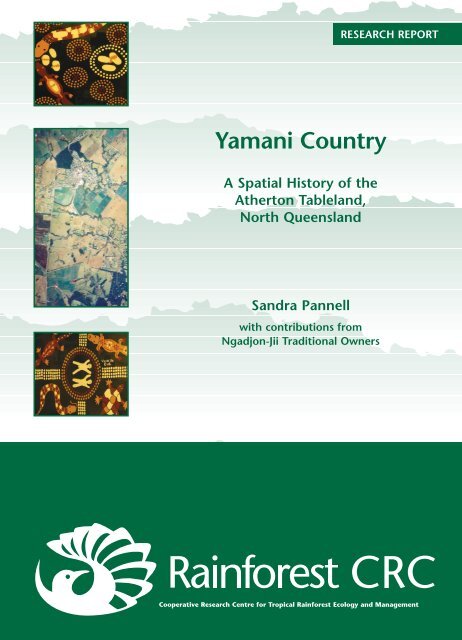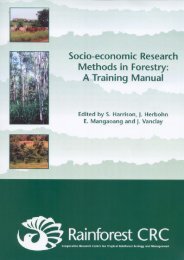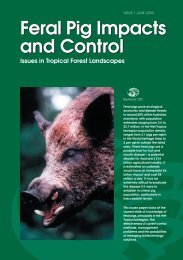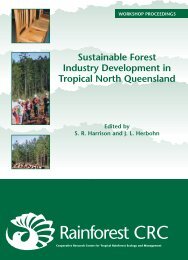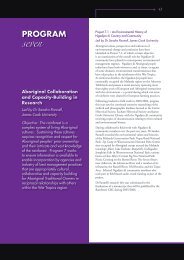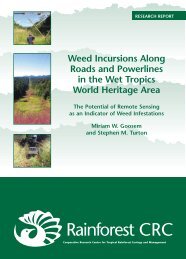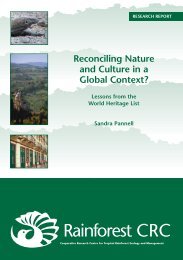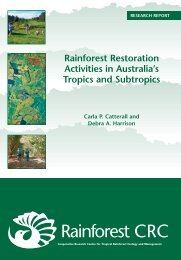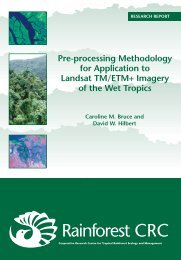Yamani Country - Rainforest Cooperative Research Centre - James ...
Yamani Country - Rainforest Cooperative Research Centre - James ...
Yamani Country - Rainforest Cooperative Research Centre - James ...
Create successful ePaper yourself
Turn your PDF publications into a flip-book with our unique Google optimized e-Paper software.
RESEARCH REPORT<strong>Yamani</strong> <strong>Country</strong>A Spatial History of theAtherton Tableland,North QueenslandSandra Pannellwith contributions fromNgadjon-Jii Traditional Owners<strong>Cooperative</strong> <strong>Research</strong> <strong>Centre</strong> for Tropical <strong>Rainforest</strong> Ecology and Management
YAMANI COUNTRYA SPATIAL HISTORY OF THEATHERTON TABLELAND, NORTH QUEENSLANDSandra Pannell<strong>Rainforest</strong> CRC, <strong>James</strong> Cook University, Cairnswith contributions from Ngadjon-Jii Traditional OwnersEmma Johnston, Ernie Raymont, Jessie Calico,Yvonne Canendo, Warren Canendo, Trevor Johnston,Billie Jean Johnston and Stanley MortaEstablished and supported under theAustralian <strong>Cooperative</strong> <strong>Research</strong> <strong>Centre</strong>s Program
© <strong>Cooperative</strong> <strong>Research</strong> <strong>Centre</strong> for Tropical<strong>Rainforest</strong> Ecology and Management.ISBN 0 86443 754 4This work is copyright. The Copyright Act 1968permits fair dealing for study, research, newsreporting, criticism or review. Selectedpassages, tables or diagrams may bereproduced for such purposes providedacknowledgment of the source is included.Major extracts of the entire document may notbe reproduced by any process without writtenpermission of the Chief Executive Officer,<strong>Cooperative</strong> <strong>Research</strong> <strong>Centre</strong> for Tropical<strong>Rainforest</strong> Ecology and Management.Published by the <strong>Cooperative</strong> <strong>Research</strong> <strong>Centre</strong>for Tropical <strong>Rainforest</strong> Ecology andManagement. Further copies may berequested from the <strong>Cooperative</strong> <strong>Research</strong><strong>Centre</strong> for Tropical <strong>Rainforest</strong> Ecology andManagement, <strong>James</strong> Cook University,PO Box 6811, Cairns QLD 4870, Australia.This publication should be cited as: Pannell, S.(2005) <strong>Yamani</strong> <strong>Country</strong>: A Spatial History ofthe Atherton Tableland, North Queensland.<strong>Cooperative</strong> <strong>Research</strong> <strong>Centre</strong> for Tropical<strong>Rainforest</strong> Ecology and Management.<strong>Rainforest</strong> CRC, Cairns. (112 pp.)Cover Images ©(Top) Painting (detail) by Warren Canendo,depicting the creation of the volcanic conesknown as the ‘Seven Sisters’. Image: RogerWilkinson.(<strong>Centre</strong>) Aerial photograph of Malanda. Image:Queensland Department of Natural Resourcesand Mines.(Bottom) Painting by Warren Canendo,depicting Djura Djilam (Mt Bartle Frere),regarded as the spiritual ‘home’ of theNgadjon-Jii people. Image: Roger Wilkinson.January 2006For copies of this document, please visitwww.rainforest-crc.jcu.edu.auThis document contains language andexpressions that some readers may findoffensive.The views expressed in this publication do notnecessarily represent those of the <strong>Rainforest</strong>CRC. While every effort has been made toensure that the information is accurate at thetime of printing, the <strong>Rainforest</strong> CRC does notaccept responsibility for any errors oromissions.Aboriginal and Torres Strait Islander Peopleshould be warned that this document containsimages of deceased persons.
<strong>Yamani</strong> <strong>Country</strong>ACKNOWLEDGEMENTSFrom a personal perspective, this volume has its origins in the mid 1990s, when I first metmany of the Ngadjon-Jii people whose words and stories appear on the following pages. Itwas on this occasion that I met Auntie Emma Johnston, her children, Trevor Johnston andYvonne Canendo, Uncle Ernie Raymont, Auntie Jessie Calico, Auntie May Morta and hersister, Ena Gertz, and some of the younger generation of Ngadjon-Jii people, WarrenCanendo, Billie-Jean Johnston, Eliza Morta, and Vanessa Gertz. To these people, and theother Ngadjon-Jii people who taught me something about the tangled histories of theTableland, I am deeply grateful.It was at our initial meeting on the shores of Lake Eacham that I first heard about <strong>Yamani</strong>.Seeing a strange ripple in the water, Auntie May Morta, now deceased, looked at the darksurface of the lake and talked about that “old <strong>Yamani</strong>, too big for a snake, too big for an eel”.I was to hear and record many more stories about <strong>Yamani</strong> in the years that followed, as wetalked about and travelled around Ngadjon-Jii country as part of research for a Native Titleclaim. In the course of these conversations with Ngadjon-Jii people, some of which tookplace sitting around the kitchen table at Yvonne’s place in Malanda, while others occurred inrainforest pockets and cleared paddocks around the district, it became apparent that theplaces we visited with memories and a motor car were complex cultural constructs. It alsobecame clear that to speak and write about the spatial history of Ngadjon-Jii people and theircountry required a different setting than the one provided by the legal parameters of NativeTitle.In late 2002, we sat down once again and talked about a different kind of project to recordstories about country and kin. These stories appear throughout this document in the form ofexcerpted transcripts of the original digital audio recordings. Some of our conversations andtravels in the ensuing period, 2003-2005, formed part of a research project funded by theAustralian Institute of Aboriginal and Torres Strait Islander Studies (AIATSIS) and the<strong>Rainforest</strong> <strong>Cooperative</strong> <strong>Research</strong> <strong>Centre</strong> (<strong>Rainforest</strong> CRC). I would like to acknowledge thesupport and encouragement received from both of these organisations. Special thanks aredue to Birgit Kuehn and Shannon Hogan at the <strong>Rainforest</strong> CRC for their untiring efforts andenthusiasm in preparing the volume for publication.In researching this book, I also spent some time exploring the archives of the CairnsHistorical Society. I am thankful to the many volunteers at the Society who offered help andassistance on these occasions.In the two years spent researching this book, a number of Ngadjon-Jii elders have passedaway. The loss of Uncle Henry Robinson, Auntie Jessie Calico and Bundji Trevor Johnstonwas deeply felt by the Aboriginal community on the Atherton Tableland. In preparing thisvolume, I reviewed some of the digital videotapes we had recorded, featuring Auntie Jessieand Trevor. While saddened by their deaths, I was also reminded of their determination tomake sure that another kind of history was told about the Atherton uplands. This book is arealisation of that determination, and is dedicated to their memory and spirit.Dr Sandra PannellLeader, Program 7<strong>Rainforest</strong> CRCi
Sandra PannellNOTES ON ORTHOGRAPHY AND KINSHIPTERMINOLOGYFor the sake of linguistic consistency, I largely follow R. M. W. Dixon’s orthography for the‘Dyirbal’ language and its six constituent dialects, including ‘Ngadyan’ (1972). According toDixon, the phonological features of Dyirbal are:(Unmarked)lingualFront (marked)lingualBack (marked)lingualLabialStop D ɖ G bNasal N ɲ ɳ mLiquid L R ɽSemi-vowel W Y W wVowel A I U uIn the available anthropological and linguistic material, a number of different orthographiesare used to record the term ‘Ngadjon-Jii’. Norman Tindale, for example, identifies fifteenalternative terms to describe this group of Aboriginal people (1974: 183). In his earlier writing,R. M. W. Dixon describes the language spoken by Emma Johnston and her family using theterms, ‘Ngadyan’ (1972) or ‘Ngadjan’ (1976). Dixon identifies the group itself with the labels‘Ngadanjdji’ or ‘Ngadyandyi’ (1980). In later writings, Dixon tends to use the terms ‘Ngajan’(1982, 1996) and ‘Ngajanji’ (1980) when respectively describing the language and the group,although ‘Ngajan’ is frequently employed as a gloss for both in his 1996 publication on‘Dyirbal Song Poetry’.As these comments indicate, inconsistency appears to mark the anthropological andlinguistic record regarding the nomenclature used to describe Ngadjon-Jii people and theirway of speaking. In keeping with Ngadjon-Jii people’s use and orthographic practices, and toavoid the confusion in the written record about ‘tribal’ and language names, throughout thisvolume I use the appellation ‘Ngadjon-Jii’ to denote the people, their language, their countryand their culture.As Dixon reports, Ngadjon-Jii people, like other Dyirbal language group speakers,acknowledge a number of kinship relationships and categories (Dixon 1996). While Ngadjon-Jii people are familiar with this Indigenous system of kinship classification and terminology,they also use English terms to gloss some of these egocentric kinship relations. It isimportant to realise here that Anglo-Australian kin terms, such as ‘Auntie’ or ‘Granny’, are notconsistent with Ngadjon-Jii kin categories where, for example, four sets of ‘Grannies’ areterminologically distinguished (i.e. bulu [FF], babi [FM], gumbul [MM], ngargi [MF] 1 ). Ngadjon-Jii people also use Anglo-Australian kin terms socio-centrically as honorifics for men andwomen who are regarded as ‘elders’ or as being somehow ‘senior’ to the speaker.Throughout this volume, I follow this practice and refer to individuals, such as EmmaJohnston and Ernie Raymont, with the appropriate anglicised term of respect.1 In line with anthropological convention regarding the study of kinship systems, the followingabbreviations and glosses are used: FF (Father’s Father), FM (Father’s Mother), MM (Mother’sMother), and MF (Mother’s Father).ii
<strong>Yamani</strong> <strong>Country</strong>CONTENTSAcknowledgements ................................................................................................................... iNotes on Orthography and Kinship Terminology ..................................................................... iiMaps........................................................................................................................................ ivPhotographs............................................................................................................................. vCHAPTER ONE – THE LIE OF THE LAND ............................................................................1Environmental Histories of Settled Australia.......................................................................3Towards a History of Cultural Spaces.................................................................................4CHAPTER TWO – YAMANI ....................................................................................................7Barriny.................................................................................................................................9Djilan.................................................................................................................................11Gubi ..................................................................................................................................14Buluba Burrguna ...............................................................................................................16Warma ..............................................................................................................................21Conclusion ........................................................................................................................26CHAPTER THREE – NATURE IN NAMES ...........................................................................29Natural Foundations: Christie Palmerston and the Mineralogical Fantasy .......................30Meaningless Names and a Pleasing Geographical Nomenclature...................................34Conclusion ........................................................................................................................37CHAPTER FOUR – LAYING BARE THE BONES OF THE SNAKE ....................................39The ‘King’ of Boonjie .........................................................................................................40The Creation of Aboriginal Labour ....................................................................................45The Old People’s Track ....................................................................................................50Back to Boonjie.................................................................................................................52Conclusion ........................................................................................................................53CHAPTER FIVE – ON THE FARM ........................................................................................55Into the Clearing................................................................................................................58Living with Miss Raymont .................................................................................................64Conclusion ........................................................................................................................70CHAPTER SIX – BUYU .........................................................................................................73Buyu..................................................................................................................................75Living on the Edge ............................................................................................................76Midja in the Midst ..............................................................................................................78Living in Change ...............................................................................................................82Edge Effects......................................................................................................................85Impacts and Threats .........................................................................................................87New Spaces, Old Places ..................................................................................................88iii
Sandra PannellCHAPTER SEVEN – AFTERWORD .....................................................................................91In the Chamber .................................................................................................................91A Landscape of Historical Leftovers .................................................................................93REFERENCES.......................................................................................................................95MAPSMap 1: The Malanda District of the Atherton Tableland, North Queensland ...................5Map 2: Allocated selections in the Parish of Malanda, 1911 .........................................56iv
<strong>Yamani</strong> <strong>Country</strong>PHOTOGRAPHSFigure 1: ‘Aboriginal group, Bellenden-Ker, with shields, spears and boomerangs’...........1Figure 2: Mosaic-tiled mural, Malanda Conservation Park .................................................7Figure 3: The creation of Barriny – Lake Barrine ................................................................9Figure 4: Yvonne Canendo and Auntie Emma Johnston at Buluba Burrguna..................17Figure 5: New signage at Buluba Burrguna: Cultural and Natural Protection Area ..........20Figure 6: ‘Blanket Issue Day for Aborigines’, Atherton, ca. 1914......................................22Figure 7: ‘Aboriginal climbing tree in English’s Jungle Avenue, Malanda’ ........................23Figure 8: ‘Aboriginals at their Natural Huts, English’s Jungle Avenue, Malanda, 1930s’..25Figure 9: Statue of ‘Christie Palmerston and his Aboriginal Companion Pompo’at Millaa Millaa, Atherton Tableland...................................................................37Figure 10: ‘Gold sluicing at Union Gold Mine, Russell River, 1890s’..................................39Figure 11: Molly Raymond, Malanda, ca. early 1990s........................................................40Figure 12: ‘A group of Aborigines, Upper Russell River 1895, with implementsand body markings’............................................................................................41Figure 13: ‘Aboriginal mummy of King Narcha of the Boonjie Tribe, 1890s’.......................44Figure 14: ‘Sluicing gold at the Mayflower Claim on the Russell River usinghydraulic sluicing’...............................................................................................46Figure 15: ‘The Raymont Brothers with Aboriginal workers, ca. 1920, Malanda’ ...............55Figure 16: ‘Coffee plantation 1900, Russell River’..............................................................57Figure 17: ‘Charlie Watson, 1912-14, outside his Malanda hut posing withthree Negroid men’ (from Mjöberg 1918)...........................................................59Figure 18: ‘Burning off scrub, Malanda 1907 at G. Plath’s farm’ ........................................60Figure 19: ‘Large felled tree, Malanda, ready to be transported to the sawmill’ .................61Figure 20: ‘View of Malanda, 1934’.....................................................................................62Figure 21: Aerial photograph of Glen Allyn, indicating location of the RaymontFarm and Nabanaba..........................................................................................64Figure 22: ‘An Aboriginal camp, Atherton Tableland, showing mia mia [midja]and dilly bag’......................................................................................................65Figure 23: Auntie Emma Johnston at Raymont’s Farm, August 2005 ................................67Figure 24: Ngadjon-Jii people and the Midja they built in the MalandaConservation Park, 2002 ...................................................................................73Figure 25: Molly Raymond standing in front of J. K.’s Farm, ca. 1960s..............................78Figure 26: The Aboriginal Settlement in Malanda, ca. mid 1990s ......................................82Figure 27: Location of Ngadjon-Jii camps and dwellings, and other placesof historical significance in Malanda ..................................................................88Figure 28: Trevor Johnston, holding his grandson, with his mother EmmaJohnston outside their Besser Block ‘camp’ on the outskirts ofMalanda, ca. early 2000 ....................................................................................89Figure 29: Djura Djilam – Mt Bartle Frere, taken from Lamins Hill......................................91v


